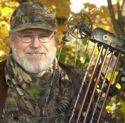This is such a great time of the year.
Outdoor enthusiasts have so much to celebrate — brightly-colored autumn leaves, campfires on cool nights, and the high-profile wildlife species that is the object of our affection and admiration.
It’s mid-October, let’s talk deer.
Bow hunters got Kentucky’s 2016-17 deer season off to a good start, tagging 5,010 deer during 28 days of hunting in September. This past weekend youth hunters bagged more than 3,100 deer, and muzzleloader hunters take to Kentucky’s woods and fields for their two-day early season Oct. 15-16.

Deer season’s main event, the 16 days of hunting with modern guns in counties of Zones 1-3, and 10 days of hunting in the Zone 4 counties, opens in 31 days, on Nov. 12.
With good weather, hunters in Kentucky typically take about 40,000 deer on opening weekend of gun season. Kentucky’s quality deer herd continues to grow, and the overall deer harvest has been in record territory three of the past five years. Last season hunters checked in a record 155,734 deer. Every season since the 2000-01 season hunters have checked in more than 100,000 deer.
It’s hard to imagine, but deer restoration in Kentucky took more than 50 years.
In March, 1999, deer restoration ended with the release of the final load of deer in Perry County. During deer restoration, 10,096 white-tailed deer were live-trapped and re-located around the state. The fall of 1999 was the first time all 120 counties were open to deer hunting.
Since restoration the white-tailed deer has become Kentucky’s number one game animal, and appreciated by all nature lovers. Wary, with inquisitive glances, keen eyesight, an acute sense of smell, the whitetail can escape to cover in the blink of an eye, bounding off in dramatic leaps.
Ingrained in Kentucky’s hunting culture, deer hunting brings families and friends together, teaches respect for firearms, and stokes rural economies. The venison that hunters bring home each fall is the most nutritious free-range meat available. It is served at meals throughout the holidays and savored all summer long, smoked over hardwood coals on backyard BBQ grills.
With a herd estimate now approaching one million, and an estimated 300,000 deer hunters, the job of deer managers in the future is to maintain the herd’s high quality and continue to provide maximum recreational opportunities, while controlling herds that have expanded into urban/suburban areas.
Let’s take a look at some interesting life history facts about the white-tailed deer (Odocoileus virginianus):
* The whitetail is native to the U.S., Canada. Mexico, Central America, and South America, as far south as Peru and Bolivia. Whitetails have been introduced to several countries around the world, including New Zealand, Finland, Czech Republic and Serbia.
* In the U.S., white-tailed deer are abundant east of the Mississippi River and found in good numbers in suitable habitat on the Great Plains. They also thrive in a handful of Rocky Mountain western states, with some of the largest herds in Wyoming and Montana.
* Deer are ruminants, equipped with a four-chambered stomach, which is necessary to process the large quantities of low-nutrient foods they eat.
During the spring, summer and early fall they consume just about anything that is green and tender, literally hundreds of species of plants, including unimaginable stuff, like poison ivy.
Their four-chambered stomach is something of a survival feature. It allows them to gather and swallow a lot of food in a short time, then chew (their cud) later, at their leisure, in a safe place. Cud is vegetative material that is regurgitated from the rumen and comes back up the gullet. It’s about the size of a big lemon.
A deer’s diet varies seasonally — from winter wheat, green grass, clover and forbs (non grass plants) in the spring, to summer’s broad leaves of trees and bushes, mushrooms, and berries. In late summer, early fall they crave apples and may end up dining under fruit trees beside rural farmhouses. September brings on a feast of acorns. In winter they consume woody browse, or farm crops, especially corn, if they can find it.
A farmer’s garden is always in danger in deer country. They love to eat green beans and lettuce, and will also devour okra and tomatoes.
* Deer are vulnerable when feeding so they move around when grabbing a bite, and prefer to feed facing into the wind, to detect predators.
* Male deer grow a new set of antlers every year. Antlers are fast-growing bone, covered with velvet and nurtured by a blood supply. Most avid deer hunters know about antler growth, but they wrongly believe that a buck’s odd-looking antlers can be blamed on “inferior genetics.” The classic example is a buck with four points on one side and a spike (one point) on the other.
But both sides of a buck’s antlers are determined by the same genetic code. There is not a “left antler” genetic code and a separate “right antler” genetic code, which is why the vast majority of whitetail bucks display left and right antlers of roughly equal shape, number of points, and spread.
Research published by the Quality Deer Management Association found that damage to a buck’s skull plate, which affects nerves and blood supply, testicular injuries, or bone fractures of their legs, through old gunshot wounds, or automobile collisions, are usually the cause of such abnormalities. Sometimes it’s a so-called “dirty shed, “ where an antler dropped in the winter fails to separate cleanly from the pedicle, where new antlers grow from the following spring.
* A deer’s home range is determined by a number of factors.
Generally does live in the best habitat an area has to offer, close to the best food sources and secure bedding/fawning cover. Bucks live on the fringes.
For more outdoors news and information, see Art Lander’s Outdoors on KyForward.
GPS technology has shed a lot of light on mature buck behavior, particularly movement patterns and home range.
The most recent research has shown that bucks have different personalities, some are roamers and some are home bodies. Generally a buck’s home range is less than a square mile, about 640 acres, but it can be much larger.
But studies substantiated that in high quality habitat, areas planted with food plots and where timber is managed for deer, providing good understory food and bedding cover, deer tend to stay put. Everything they need is close at hand. Their home ranges are much smaller, proving the premise that active land management is a key to quality hunting.
Tracking also found that as some bucks, not all, grow older, they tend to move around less.
* The timing of the rut is the question every deer hunter wants answered.
Here in Kentucky, what some hunters call the late pre-rut, begins when bucks start actively searching for does going into estrus. This is usually sometime in the first week of November, with the actual breeding phase of the rut, beginning close to opening day of modern gun season.
Photoperiod is the main factor that determines the timing of the rut. Shorter days, longer nights, trigger hormonal changes in does. Their pineal glands release melatonin, a substance that influences the release of sex hormones from the pituitary gland.
During the dark moon phase, the best hunting is often early mornings. During a full moon, hunt midday. Does that have been out all night, will get restless my midday and get up to feed, triggering buck movement. During the first and last quarter moon periods, afternoon hunting is usually best.
According to the Kentucky Department of Fish and Wildlife Resources, the annual economic impact of deer hunting is more than $400 million and accounts for nearly 4,000 jobs.
The white-tailed deer is the very essence of stealth and grace, a symbol of wild Kentucky, and the many fall hunting seasons for deer, have an important social, cultural and economic impacts on rural Kentucky.
Art Lander Jr. is outdoors editor for NKyTribune and KyForward. He is a native Kentuckian, a graduate of Western Kentucky University and a life-long hunter, angler, gardener and nature enthusiast. He has worked as a newspaper columnist, magazine journalist and author and is a former staff writer for Kentucky Afield Magazine, editor of the annual Kentucky Hunting & Trapping Guide and Kentucky Spring Hunting Guide, and co-writer of the Kentucky Afield Outdoors newspaper column.






















